Employee Advocacy Glossary
Want to learn more? Get in touch!
Whether you work with company communication, marketing and human resources, engaging your employees have never been more more important. I have worked with employee advocacy for 6 years, and in this blog I will share 7 tips and tricks to boost your employee advocacy program.
These tips are a combination of what I wish I would have known over the years and the shortcomings I still see across various companies.
They are build to be actionable insights that you can use to help your organization become more successful with employee advocacy.
Employee engagement can be defined as the strength of the mental and emotional connection employees feel towards their place of work. But how do you measure mental and emotional connection?
In our world, employee’s engagement on social media on behalf of the company, is the definition of employee engagement. And fortunately, that is measurable.
Employee Advocacy Glossary
Want to learn more? Get in touch!
So which metrics do you need to start or sustain your Employee Advocacy (EA) program?
Obviously the most important metric is the number of engagements that your program is generating. And therefore you should be monitoring the development over time. It is the single best indicator that your company is growing your relationship with your employees.
Here is an example from one of our clients that have vastly improved employee engagement over time;
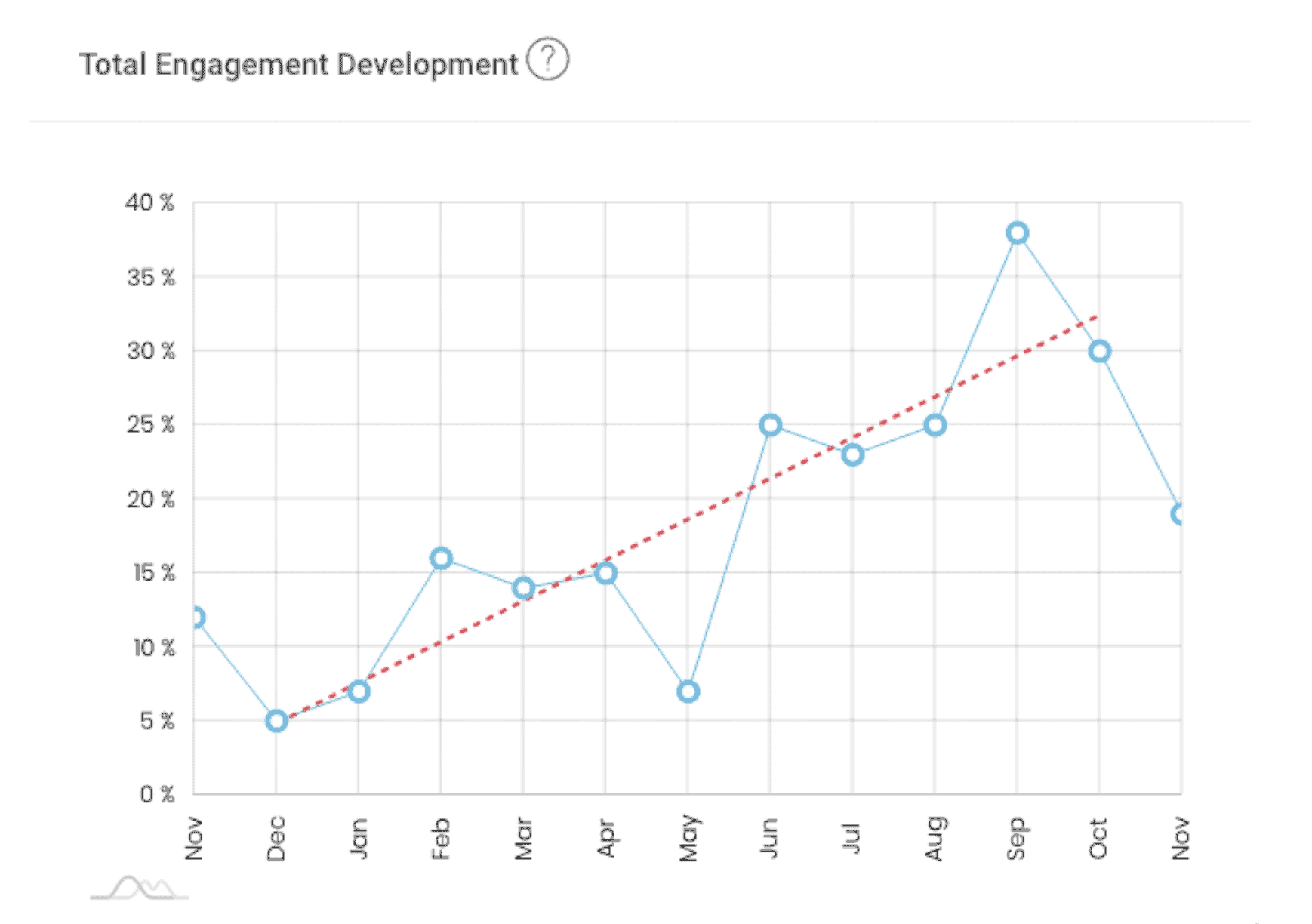
Now engagement calls for adaption. You have to be able to measure the employee adaption of your program – and correlate it with the employee engagement. Here’s why:
We work with the adaption rate as a key KPI for all our clients. (NOTE: Adaption rate is the number of engaged employees divided by total number of employees)
So what does that look like? Here is an example of a successful trendline on adaption rate from one of our clients – showing increased adaption over the course of 10 months;
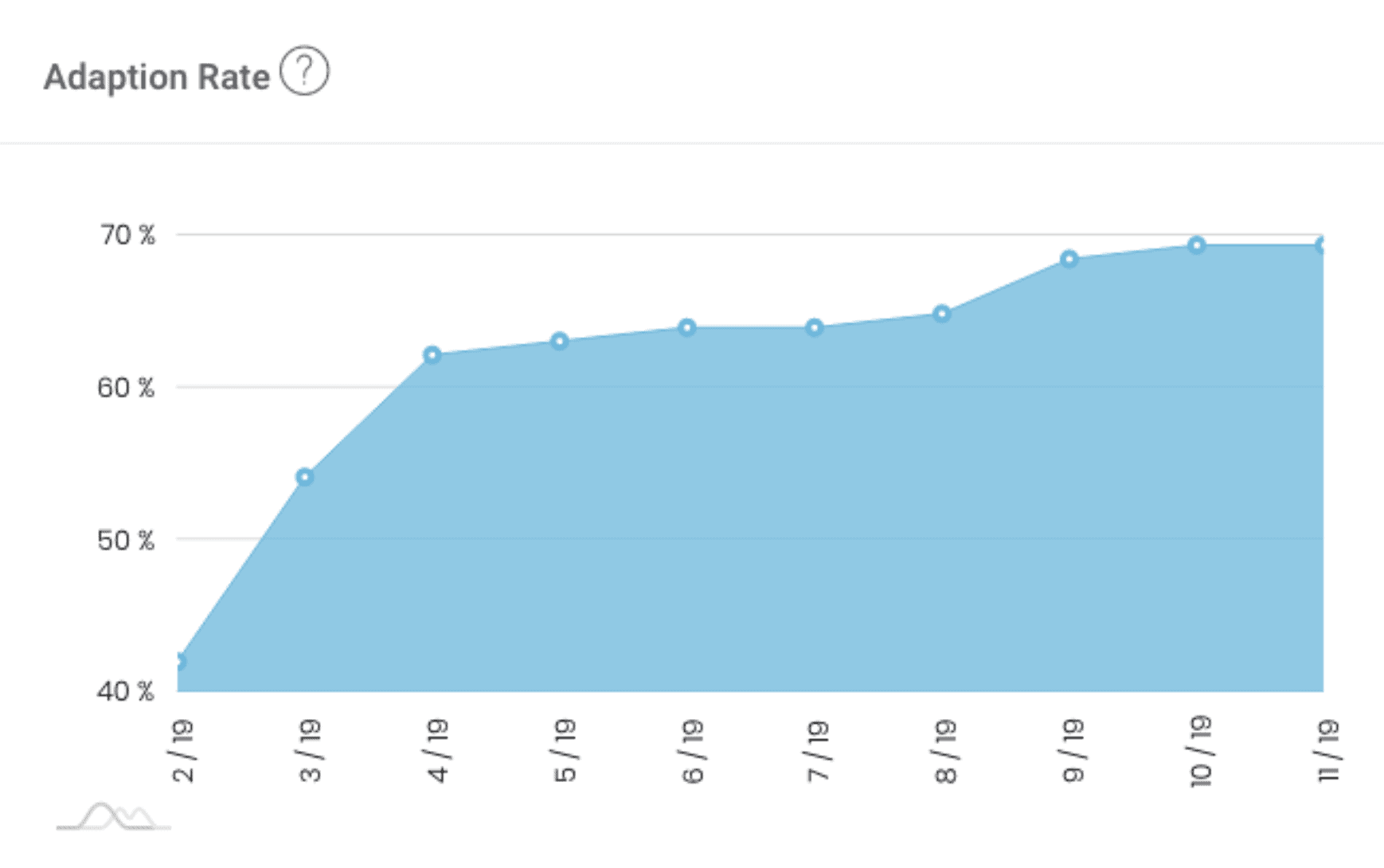
There are many other insights and stats to be considered, but getting your engagement and adaption metrics in place is the foundation you need to measure and improve your Employee Advocacy program.
We have all been hunting likes, followers and shares. But they do not impress the c-suite (or any experienced digital marketeer) anymore. What you need to show in order to take your Employee Advocacy program to the next level, is that employee engagement could actually be a source of saving or even making money;-)
But unless you can show it…..
We have created an earned media value calculator where you can see how much you can save by increasing your employee advocacy performance through the Sociuu platform. Check it out:
Pricing And Earned Media Value [old]
Calculate your Earned Media Value
Whenever possible you should utilize your existing analytics tool to track the content shared by employees. Especially when the content holds a call to action. But indeed also in relation to i.e. employer branding campaigns, job posts, thought leaderships etc.
If you are interested in learning more about the the importance and benefits of employee advocacy, you can read the following blogpost:
Employee Advocacy: Definition, Importance and Benefits
Want to learn more? Get in touch!
Let us say that you are running paid content in your recruitment efforts and you want to investigate if you could cut costs (while also up the applicant quantity/quality) in this area by using your EA program to get employees to attract and refer candidates.
To do so, you just need to add tags to your landing page for your specific job post.
Here is the step by step guide using Sociuu:
1 – Set up your post;

2 – Set up your tags
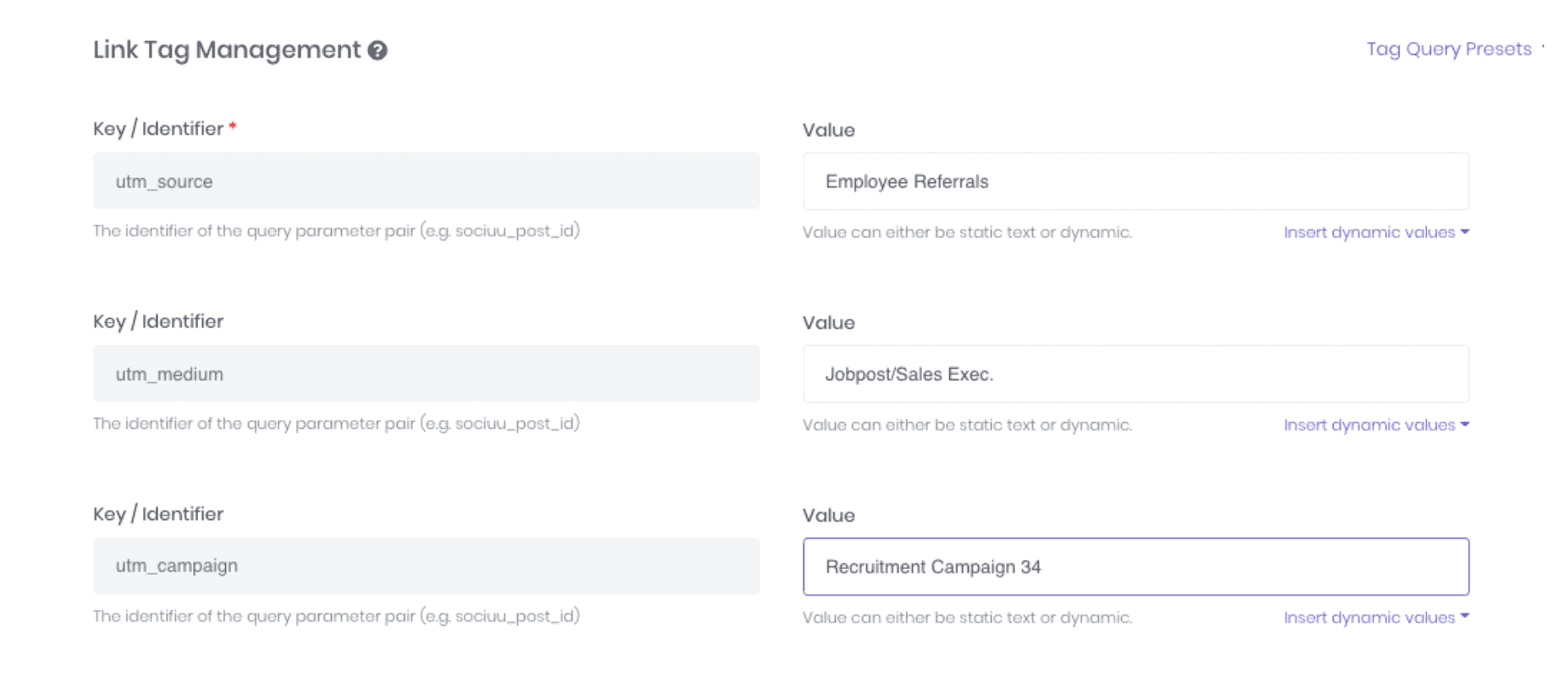
3 – Invite employees to share
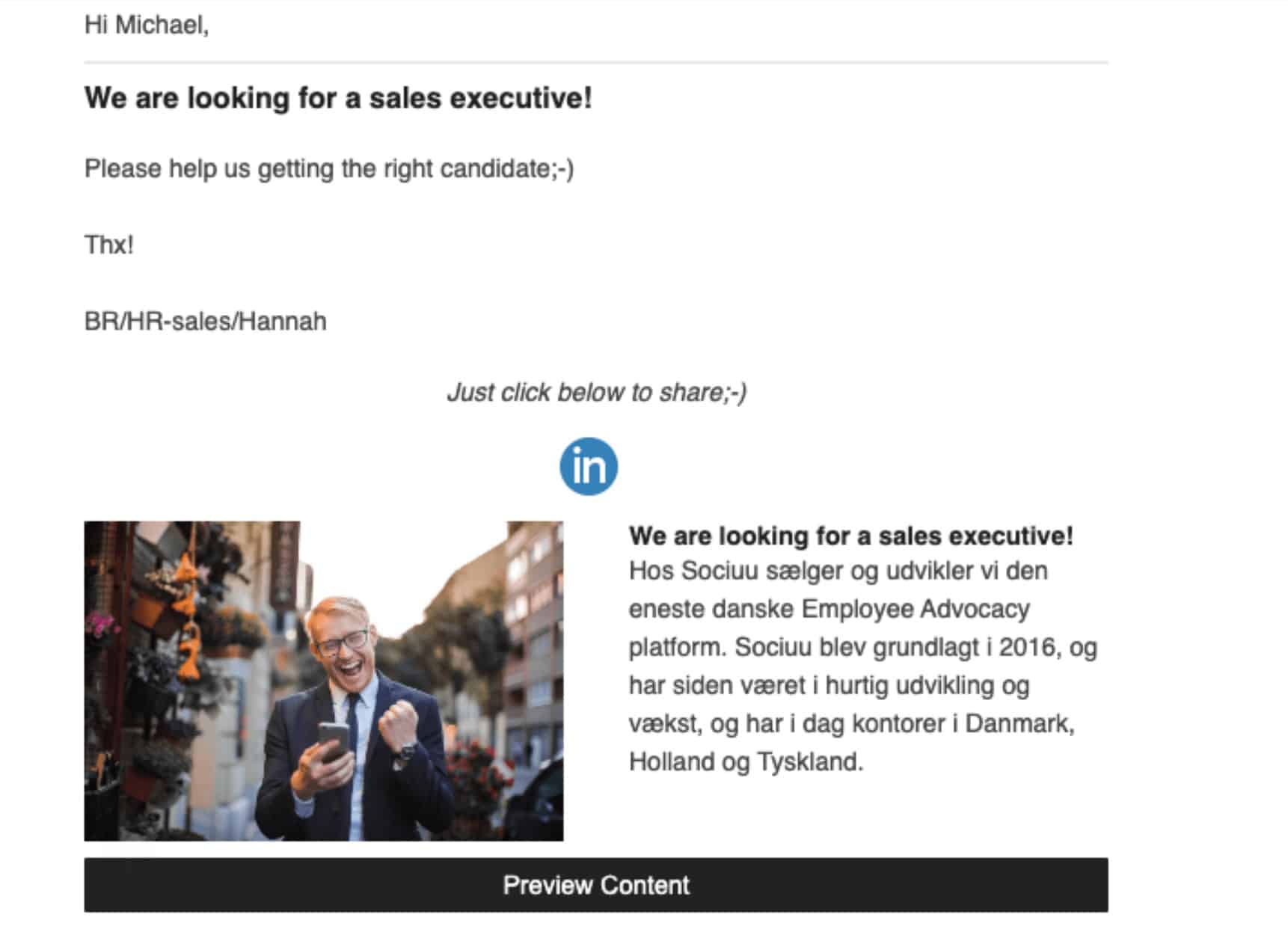
And that’s it. you’re done!
If you in parallel run the same paid job post/recruitment campaigns you will be able to monitor which approach proves to be the best and get insights if you could cut costs or improve in other ways.
Employee candidate referrals via your EA program is something we have experienced being very effective both in relations to quantity and quality. In fact, the same method should be used for all content considered measurable in a business impact perspective.
Hashtags are well-known and often-used on Social Media sites like Instagram, Facebook, Twitter and Pinterest. LinkedIn joined the club in 2018 and since then it has exponentially increased in popularity.
Hashtags on LinkedIn provides you with a great opportunity to increase your visibility through relevant hashtags on your post.
The first thing you need is a quick assessment of the popular hashtags that are being used.
Let us try a use case for this purpose: You are working in Human Resources for an engineering company, and you are tasked with the job of using LinkedIn to recruit engineers for new job openings in your company. Here’s what you could do:
Go to LinkedIn and search for relevant hashtags, like engineering, engineer or #jobs.
For #engineering we got 1,132,084 followers of that hashtag.

Now we could go with some of the above hashtags only or narrow/focus our target audience with #engineeringjobs as well.

As you can see we have 1,132,084 followers of engineering and 2,807 followers of engineeringjobs.
Include these hashtags in your recruitment post, and increase your chances of getting seen ten-fold!
Combine this with the before mentioned process of nudging your employees to share the job post and I bet there will not be a scarcity in number of qualified candidates.
In fact, we have a real-world case study that centers around this exact situation. Read the Rambøll case here:
Rambøll Employer Branding
Other than working with an Employee Advocacy platform – like Sociuu;-) – there are also several other vital things to consider in order to boost your organic reach through employee engagement.
– Make sure you involve your colleagues in the content development process.
– Get feedback. When employees feel involved, they’re more likely to engage and share content.
– With an employee advocacy platform – promo alert: like ours;-) – you can measure what is being shared and by whom; then create more like it.
A/B testing is one of the oldest trick in the book when you are talking about performance optimization.
It is a split testing method comparing single-variable test samples to determine which variable gives you the best performance. So basically, A/B testing is exactly what the name suggests it is.
The process is illustrated below:
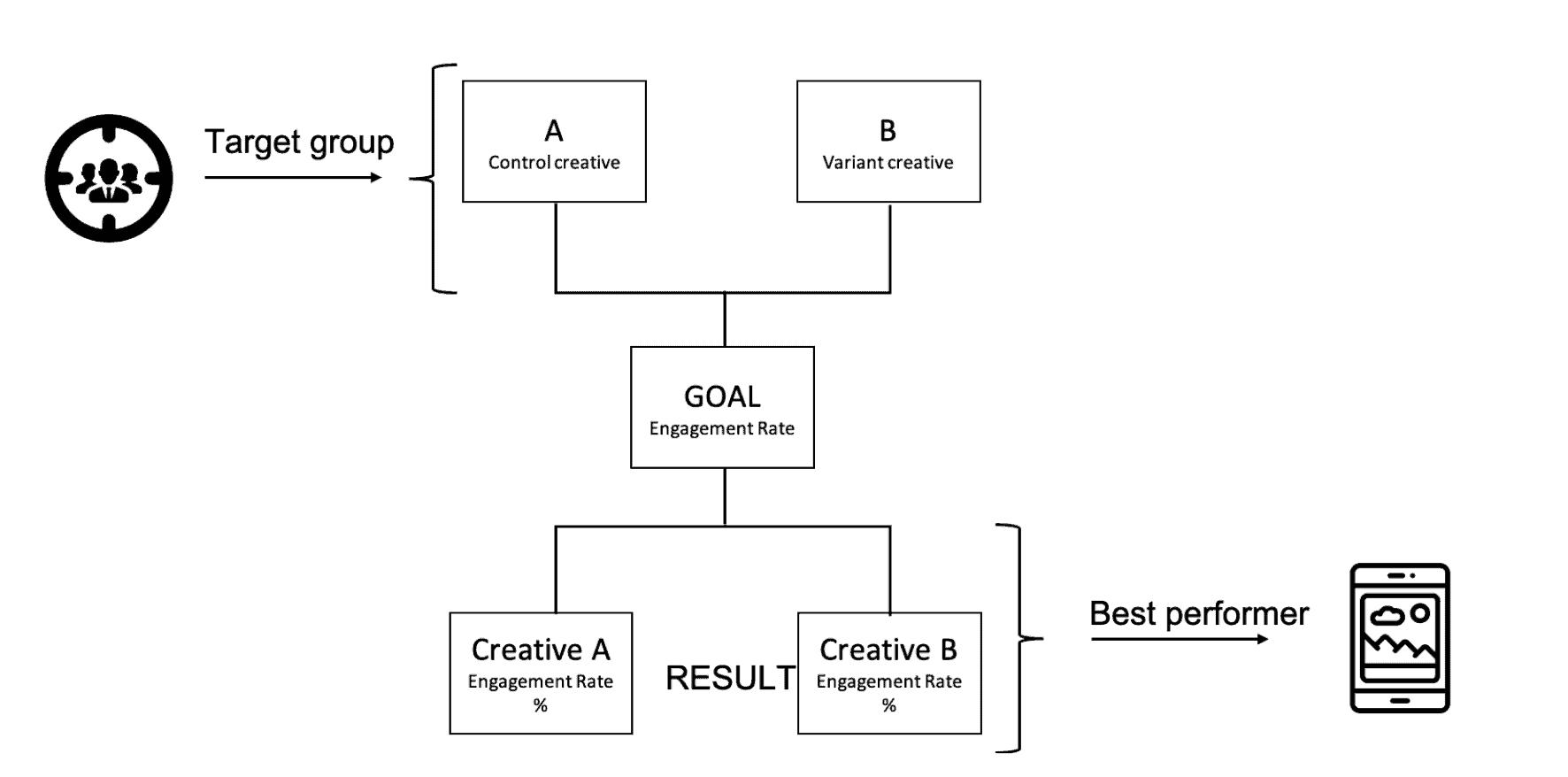
What are the pitfalls?
A/B testing is a very simple performance optimization process, but there is one pitfall that I often see over and over again; changing more than one variable, or what is also termed multivariate testing and still evaluating like a simple A/B test.
If you want to test whether a post performs better with a male or female in your LinkedIn post, but you also end up having a different contexts of the image, e.g. relaxed private environment vs. a corporate office environment. Or if you also change the copy of the posts slightly, you will not be able to single out the positive variable.
This mistake can lead you to wrong conclusions and thereby cause you to make bad decisions. This is something to be very wary about when conducting an A/B test.
What can you test?
What you test should be a reflection of your end goal. The most important thing is that there is a noticeable difference between the two test objects.
And the list goes on…..
Do not let your employees drown in the blue sea of LinkedIn!

We all have the possibility to upload a background image on our LinkedIn profiles, just like the CEO of LinkedIn Jeff Weiner.

But unfortunately, there are a great many who do not have one.
My experience tells me these are the most common reasons for not changing that image:
Employees want to represent the brand they work fo. As a company you must provide them the right tools and guidance. My suggestion is to create an image bank for your employees to choose from. It could consist of:
LinkedIn even have a short and easy tutorial that you can share with your colleagues.
Maybe even do it today. It is the little things that count.
The fact that employees engage with the company’s content and share it with their network is super cool, and it strengthens both the employee’s own brand and the company’s.
However, a slightly overlooked opportunity regarding employee advocacy is “tagging” people in one’s network. Or at least encouraging the employee to consider it when sharing content.
Here’s why you should tag a person?
The short answer is that you can immediately get interest – and instant feedback – on your content from peers and likeminded.
When should you tag a person?
If there is a high relevance to specific people it always makes sense to use this engagement hack.
But do not overdo it. If it is done too often and if relevancy declines it will lose its effect. So use tagging wisely, and it is a great tool for your employees to increase reach and engagement.
When is it relevant in an Employee Advocacy context?
Of course, it should always be up to the employee when they tag persons from their network, but in the following examples it makes good sense to nudge it through your employee advocacy program:
There are certainly several other areas where tagging people can be beneficial for your content, but the great exercise in terms of employee advocacy is how to get employees involved in the idea. Happy tagging!
I hope you find above tips relevant, and feel free to contact us if you have any questions about Employee Advocacy or the Sociuu platform:-)